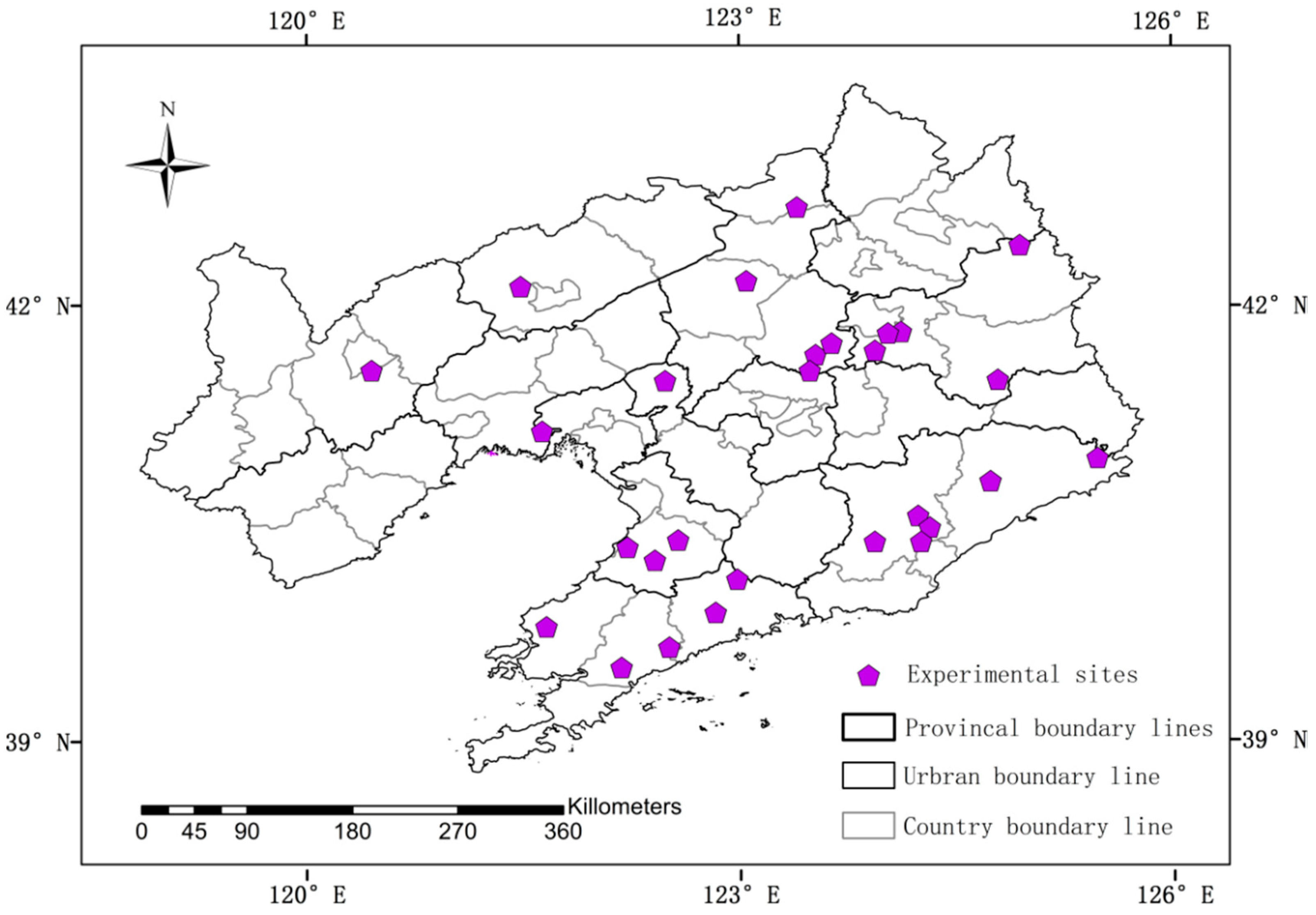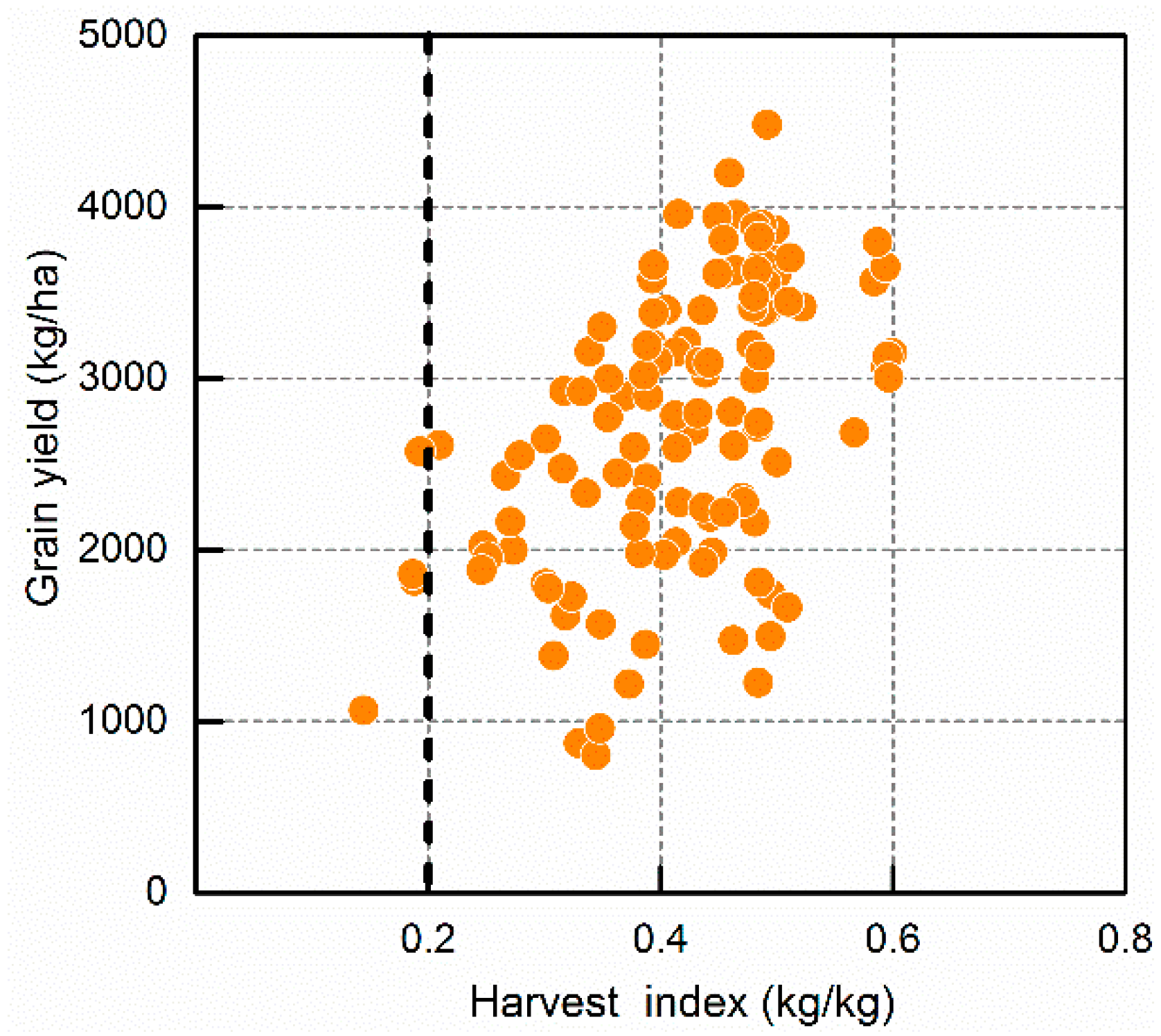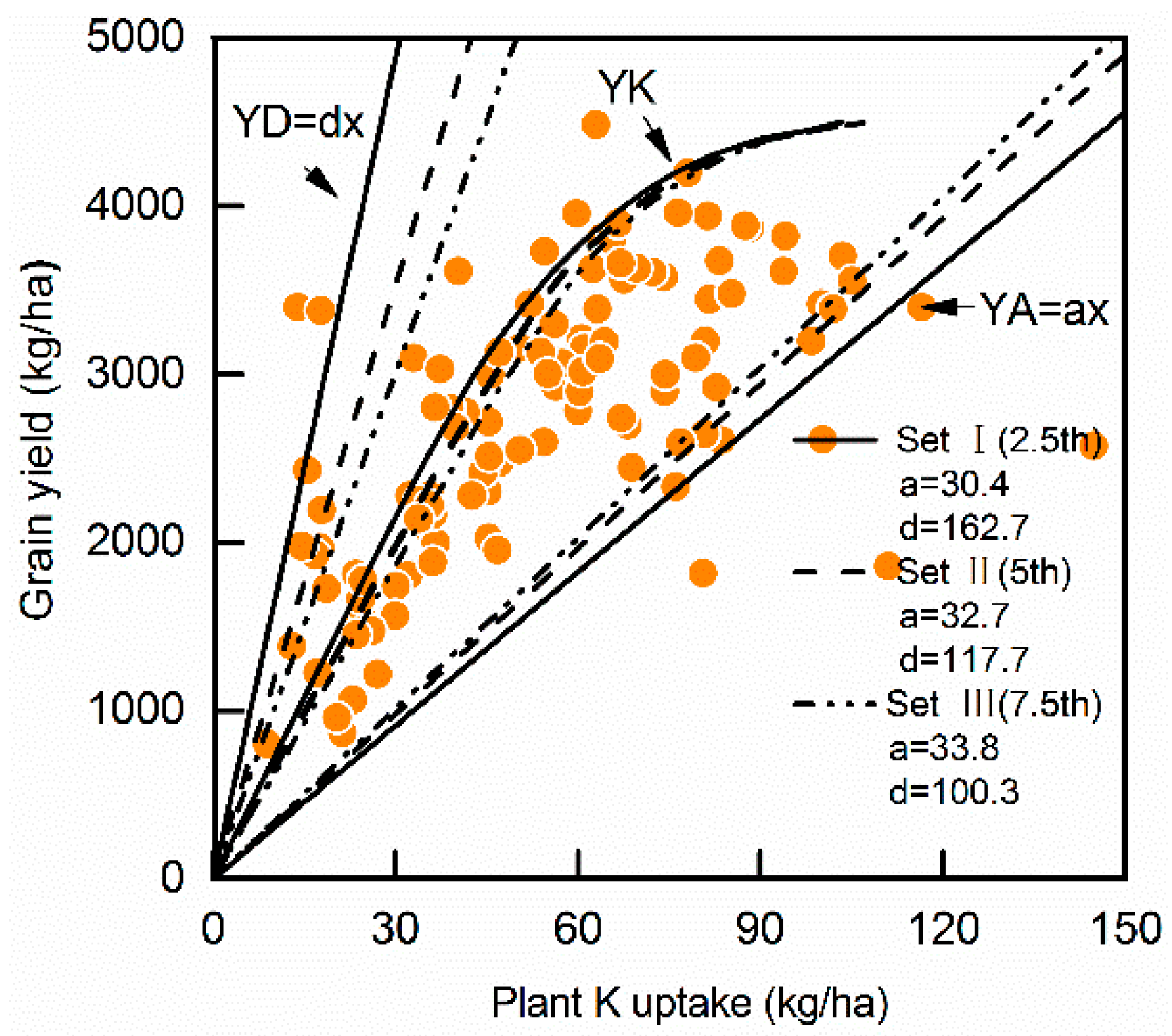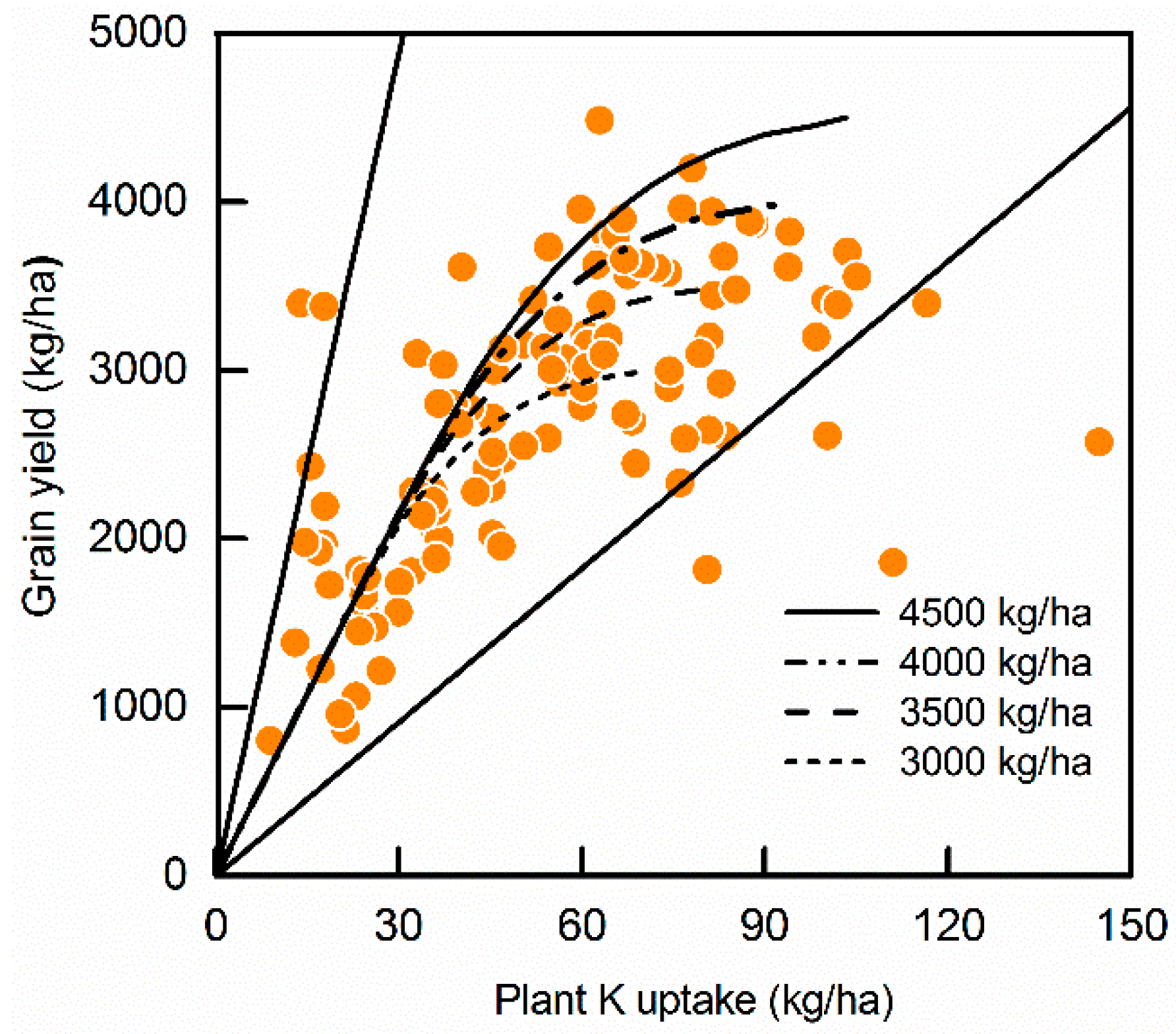Characteristics of Yield and Harvest Index, and Evaluation of Balanced Nutrient Uptake of Soybean in Northeast China
Abstract
1. Introduction
2. Materials and Methods
2.1. Database Source and Study Sites
2.2. Field Experiment Treatment and Management
2.3. Sampling and Measuring
2.4. Using the QUEFTS Model Analysis
3. Results and Discussion
3.1. Characteristics of Yield, Nutrient Concentrations, Nutrient Harvest Index (HI)
3.2. Characteristics of Internal Efficiency (IE)
3.3. Data Screening for the QUEFTS Model
3.4. The Boundary for the QUEFTS Model
3.5. Estimating the Balanced Nutrient Uptake at Different Potential Yields for Soybean
4. Conclusions
Author Contributions
Funding
Conflicts of Interest
References
- Wang, X.K.; Fan, J.L.; Xing, Y.Y.; Xu, G.C.; Wang, H.D.; Deng, J.; Wang, Y.F.; Zhang, F.C.; Li, P.; Li, Z.B. The effects of mulch and nitrogen fertilizer on the soil environment of crop plants. Adv. Agron. 2019, 153, 121–173. [Google Scholar]
- Godfray, H.C.J.; Beddington, J.R.; Crute, I.R.; Lawrence, H.; David, L.; Muir, J.F.; Jules, P.; Sherman, R.; Thomas, S.M.; Camilla, T. Food security: The challenge of feeding 9 billion people. Science 2010, 327, 812–818. [Google Scholar] [CrossRef]
- Li, X.; Xu, Z.; Guo, C.; Ren, T.; Cong, R.; Lu, J. Grain yield and nitrogen use efficiency of various modern rice cultivars grown at different nitrogen levels. J. Plant Nutr. 2017, 40, 1125–1132. [Google Scholar] [CrossRef]
- Liu, X.; Jin, J.; Wang, G.; Herbert, S.J. Soybean yield physiology and development of high-yielding practices in Northeast China. Field Crops Res. 2008, 105, 157–171. [Google Scholar] [CrossRef]
- Yang, F.; Xu, X.; Wang, W.; Ma, J.; Wei, D.; He, P.; Pampolino, M.F.; Johnston, A.M. Estimating nutrient uptake requirements for soybean using QUEFTS model in China. PLoS ONE 2017, 12, e0177509. [Google Scholar] [CrossRef]
- Ball, R.A.; Purcell, L.C.; Vories, E.D. Optimizing soybean plant population for a short-season production system in the southern USA. Crop Sci. 2000, 40, 757–764. [Google Scholar] [CrossRef]
- Mueller, N.D.; Gerber, J.S.; Matt, J.; Ray, D.K.; Navin, R.; Foley, J.A. Closing yield gaps through nutrient and water management. Nature 2013, 494, 390. [Google Scholar] [CrossRef]
- Xu, X.; He, P.; Yang, F.; Ma, J.; Pampolino, M.F.; Johnston, A.M.; Zhou, W. Methodology of fertilizer recommendation based on yield response and agronomic efficiency for rice in China. Field Crops Res. 2017, 206, 33–42. [Google Scholar] [CrossRef]
- Guo, J.H.; Liu, X.J.; Zhang, Y.; Shen, J.L.; Han, W.X.; Zhang, W.F.; Christie, P.; Goulding, K.W.T.; Vitousek, P.M.; Zhang, F.S. Significant acidification in major Chinese croplands. Science 2010, 327, 1008–1010. [Google Scholar] [CrossRef]
- Wang, X.K.; Li, Z.B.; Xing, Y.Y. Effects of mulching and nitrogen on soil temperature, water content, nitrate-N content and maize yield in the Loess Plateau of China. Agric. Water Manag. 2015, 161, 53–64. [Google Scholar]
- Zhang, B.; Feng, G.; Kong, X.; Lal, R.; Ying, O.; Adeli, A.; Jenkins, J.N. Simulating yield potential by irrigation and yield gap of rainfed soybean using APEX model in a humid region. Agric. Water Manag. 2016, 177, 440–453. [Google Scholar] [CrossRef]
- Xu, X.; Xie, J.; Hou, Y.; He, P.; Pampolino, M.F.; Zhao, S.; Qiu, S.; Johnston, A.M.; Zhou, W. Estimating nutrient uptake requirements for rice in China. Field Crops Res. 2015, 180, 37–45. [Google Scholar] [CrossRef]
- Janssen, B.H.; Guiking, F.C.T.; Der Eijk, D.V.; Smaling, E.M.A.; Wolf, J.; Van Reuler, H.A. System for quantitative evaluation of the fertility of tropical soils (QUEFTS). Geoderma 1990, 46, 299–318. [Google Scholar] [CrossRef]
- Smaling, E.M.A.; Janssen, B.H. Calibrating of QUEFTS, a model predicting nutrient uptake and yields from chemical soil fertilty indices. Geoderma 1993, 59, 21–44. [Google Scholar] [CrossRef]
- Witt, C.; Dobermann, A.; Abdulrachman, S.; Gines, H.C.; Guanghuo, W.; Nagarajan, R.; Satawatananont, S.; Son, T.T.; Tan, P.S.; Simbahan, G.C.; et al. Internal nutrient efficiencies of irrigated lowland rice in tropical and subtropical Asia. Field Crops Res. 1999, 63, 113–138. [Google Scholar] [CrossRef]
- Liu, M.Q.; Yu, Z.R.; Liu, Y.H.; Konijn, N.T. Fertilizer requirements for wheat and maize in China: The QUEFTS approach. Nutr. Cycl. Agroecosyst. 2006, 74, 245–258. [Google Scholar] [CrossRef]
- Ren, T.; Zou, J.; Wang, Y.; Li, X.K.; Cong, R.H.; Lu, J.W. Estimating nutrient requirements for winter oilseed rape based on QUEFTS analysis. J. Agric. Sci. 2016, 154, 425–437. [Google Scholar] [CrossRef]
- Chuan, L.; He, P.; Jin, J.; Li, S.; Grant, C.; Xu, X.; Qiu, S.; Zhao, S.; Zhou, W. Estimating nutrient uptake requirements for wheat in China. Field Crops Res. 2013, 146, 96–104. [Google Scholar] [CrossRef]
- Pathak, H.; Aggarwal, P.K.; Roetter, R.; Kalra, N.; Bandyopadhaya, S.K.; Prasad, S.; Van, K.H. Modelling the quantitative evaluation of soil nutrient supplies, nutrient use effi ciency, and fertilizer requirements of wheat in India. Nutr. Cycl. Agroecosyst. 2003, 65, 105–113. [Google Scholar] [CrossRef]
- Li, S.T.; Jin, J.Y. Characteristics of nutrient input/output and nutrient balance in different regions of China. Sci. Agric. Sin. 2011, 44, 4207–4229. (In Chinese) [Google Scholar]
- Klikocka, H.; Cybulska, M.; Nowak, A. Efficiency of fertilization and utilization of nitrogen and sulphur by the spring wheat. Pol. J. Environ. Stud. 2017, 26, 2029–2036. [Google Scholar] [CrossRef]
- FAOSTAT. Food and Agriculture Organization of the United Nations. Agricultural Production Data. Available online: http://www.fao.org/faostat/en/.
- Salvagiotti, F.; Cassman, K.G.; Specht, J.E.; Walters, D.T.; Weiss, A.; Dobermann, A. Nitrogen uptake fixation and response to fertilizer N in soybeans: A review. Field Crops Res. 2008, 108, 1–13. [Google Scholar] [CrossRef]






| Parameter | Unit | Mean | Min | 25% Quartile | Median | 75% Quartile | Max |
|---|---|---|---|---|---|---|---|
| Grain yield | kg/ha | 2731 | 804 | 2070 | 2793 | 3401 | 4484 |
| Harvest index | kg/kg | 0.42 | 0.14 | 0.35 | 0.43 | 0.48 | 0.60 |
| N concentration of grain | g/kg | 45.7 | 19.4 | 42.0 | 45.9 | 51.0 | 63.8 |
| P concentration of grain | g/kg | 5.0 | 1.4 | 3.6 | 4.9 | 6.2 | 10.3 |
| K concentration of grain | g/kg | 10.1 | 1.7 | 8.1 | 11.1 | 12.3 | 17.4 |
| N concentration of straw | g/kg | 14.1 | 4.8 | 11.6 | 14.6 | 17.0 | 29.0 |
| P concentration of straw | g/kg | 1.8 | 0.7 | 1.3 | 1.6 | 2.0 | 11.8 |
| K concentration of straw | g/kg | 6.7 | 1.7 | 4.1 | 6.5 | 8.3 | 14.8 |
| Plant N uptake | kg/ha | 182.6 | 58.6 | 284.7 | 151.5 | 186.8 | 213.2 |
| Plant P uptake | kg/ha | 21.2 | 3.5 | 61.6 | 13.9 | 18.4 | 26.6 |
| plant K uptake | kg/ha | 54.6 | 8.9 | 144.8 | 34.2 | 54.1 | 74.2 |
| N Harvest index | g/g | 0.69 | 0.25 | 0.91 | 0.62 | 0.71 | 0.80 |
| P Harvest index | g/g | 0.65 | 0.12 | 0.88 | 0.57 | 0.68 | 0.76 |
| K Harvest index | g/g | 0.52 | 0.14 | 0.78 | 0.43 | 0.55 | 0.64 |
| Parameter | Unit | Mean | Min | 25% Quartile | Median | 75% Quartile | Max |
|---|---|---|---|---|---|---|---|
| IEN | kg/kg | 15.3 | 8.9 | 13.9 | 15.0 | 16.8 | 24.1 |
| IEP | kg/kg | 149.5 | 42.5 | 116.1 | 134.1 | 184.1 | 310.5 |
| IEK | kg/kg | 60.7 | 26.1 | 44.5 | 54.4 | 66.2 | 243.9 |
| RIEN | kg/t | 66.9 | 41.5 | 59.6 | 66.8 | 72.1 | 112.6 |
| RIEP | kg/t | 7.7 | 3.2 | 5.4 | 7.5 | 8.6 | 23.5 |
| RIEK | kg/t | 19.0 | 4.1 | 15.1 | 18.4 | 22.5 | 38.4 |
© 2019 by the authors. Licensee MDPI, Basel, Switzerland. This article is an open access article distributed under the terms and conditions of the Creative Commons Attribution (CC BY) license (http://creativecommons.org/licenses/by/4.0/).
Share and Cite
Jiang, W.; Liu, X.; Wang, X.; Yin, Y. Characteristics of Yield and Harvest Index, and Evaluation of Balanced Nutrient Uptake of Soybean in Northeast China. Agronomy 2019, 9, 310. https://doi.org/10.3390/agronomy9060310
Jiang W, Liu X, Wang X, Yin Y. Characteristics of Yield and Harvest Index, and Evaluation of Balanced Nutrient Uptake of Soybean in Northeast China. Agronomy. 2019; 9(6):310. https://doi.org/10.3390/agronomy9060310
Chicago/Turabian StyleJiang, Wenting, Xiaohu Liu, Xiukang Wang, and Yuan Yin. 2019. "Characteristics of Yield and Harvest Index, and Evaluation of Balanced Nutrient Uptake of Soybean in Northeast China" Agronomy 9, no. 6: 310. https://doi.org/10.3390/agronomy9060310
APA StyleJiang, W., Liu, X., Wang, X., & Yin, Y. (2019). Characteristics of Yield and Harvest Index, and Evaluation of Balanced Nutrient Uptake of Soybean in Northeast China. Agronomy, 9(6), 310. https://doi.org/10.3390/agronomy9060310






